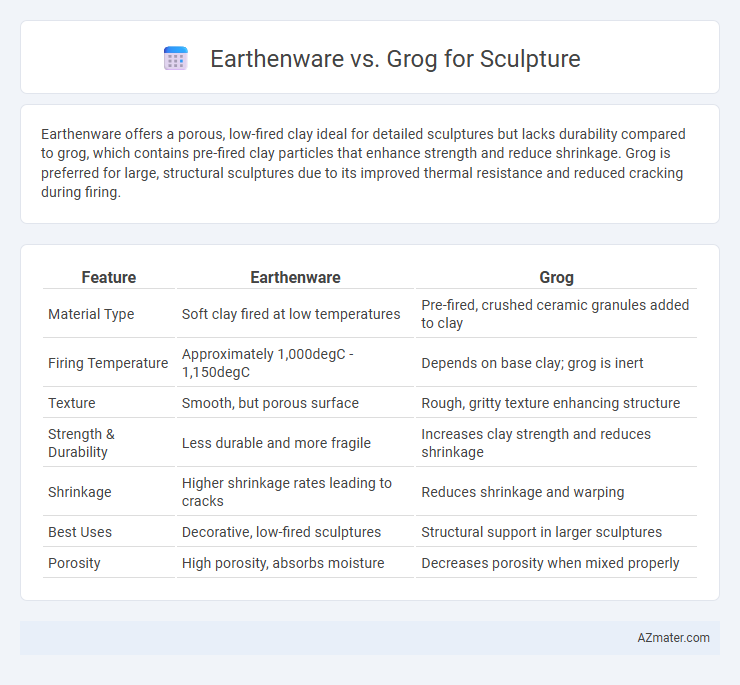Earthenware offers a porous, low-fired clay ideal for detailed sculptures but lacks durability compared to grog, which contains pre-fired clay particles that enhance strength and reduce shrinkage. Grog is preferred for large, structural sculptures due to its improved thermal resistance and reduced cracking during firing.
Table of Comparison
| Feature | Earthenware | Grog |
|---|---|---|
| Material Type | Soft clay fired at low temperatures | Pre-fired, crushed ceramic granules added to clay |
| Firing Temperature | Approximately 1,000degC - 1,150degC | Depends on base clay; grog is inert |
| Texture | Smooth, but porous surface | Rough, gritty texture enhancing structure |
| Strength & Durability | Less durable and more fragile | Increases clay strength and reduces shrinkage |
| Shrinkage | Higher shrinkage rates leading to cracks | Reduces shrinkage and warping |
| Best Uses | Decorative, low-fired sculptures | Structural support in larger sculptures |
| Porosity | High porosity, absorbs moisture | Decreases porosity when mixed properly |
Introduction to Earthenware and Grog in Sculpture
Earthenware is a porous ceramic material fired at low temperatures, often chosen for its ease of shaping and vibrant glazing possibilities in sculpture. Grog, made from ground, fired clay, is added to clay bodies to improve workability, reduce shrinkage, and increase strength, making it essential in large or detailed sculptures. Combining earthenware with grog enhances structural stability while maintaining the material's artistic versatility and surface texture.
Defining Earthenware: Composition and Properties
Earthenware is a porous ceramic material composed primarily of clay mixed with natural minerals like iron oxide and quartz, fired at temperatures between 1,000degC and 1,150degC. Its low firing temperature results in a relatively soft, absorbent, and less durable surface compared to stoneware or porcelain, making it ideal for sculptural works that benefit from ease of shaping and detailed texturing. The addition of grog, a granular fired clay, enhances earthenware's structural strength and reduces shrinkage during firing, improving overall stability and workability for complex sculptures.
Understanding Grog: What It Is and How It's Made
Grog is a granular material made from crushed, fired clay that is added to earthenware clay to improve its structural integrity and reduce shrinkage during drying and firing. It enhances the clay's porosity and strength, making it ideal for sculptors who require more durable and less crack-prone pieces. The grog's particle size and composition can be tailored during production to suit specific sculptural techniques and kiln temperatures.
The Role of Clay Body Selection in Sculptural Practice
Selecting an appropriate clay body is crucial in sculptural practice, as earthenware offers plasticity and ease of manipulation, ideal for intricate detailing and organic forms. Grog, added to the clay, enhances structural strength and reduces shrinkage, making it essential for large-scale or heavyweight sculptures requiring durability and reduced cracking. Understanding the balance between earthenware's workability and grog's reinforcing properties enables sculptors to optimize texture, stability, and firing outcomes for their artistic vision.
Workability: Texture and Handling Differences
Earthenware clay offers a smooth, pliable texture that is easy to manipulate, making it ideal for detailed sculpting and fine surface work. Grog-added clay contains coarse, granular particles that improve structural strength and reduce shrinkage but result in a rougher texture that can challenge precise detailing. Sculptors often choose earthenware for delicate forms and grog-infused clay for sturdier, larger pieces requiring enhanced support and reduced warping.
Structural Strength: Earthenware vs Grog in Sculptures
Earthenware clay, being softer and more porous, generally offers less structural strength compared to grog-enhanced clay, which includes fired ceramic particles that improve durability and reduce shrinkage. Grog increases the clay's mechanical integrity, allowing sculptures to better withstand stress and weight without cracking during drying or firing. Consequently, artists aiming for robust, large-scale sculptures often prefer grog for its superior ability to maintain structural strength and prevent deformation.
Surface Finish and Detail Retention
Earthenware offers a smooth surface finish but is more susceptible to chipping, making fine detail retention challenging over time. Grog, consisting of crushed fired clay, enhances structural strength and reduces shrinkage, allowing sculptors to achieve sharper, more durable surface details. The inclusion of grog results in a textured finish that supports intricate features without compromising the sculpture's overall integrity.
Firing Temperatures and Thermal Stability
Earthenware typically fires at lower temperatures ranging from 1000degC to 1150degC, resulting in a porous and less thermally stable surface compared to grog-enhanced clay bodies. Grog, consisting of pre-fired and ground clay, improves thermal stability by reducing shrinkage and cracking during firing, allowing sculptors to work at higher temperatures up to 1300degC. The inclusion of grog increases resistance to thermal shock, making it ideal for complex sculptures requiring durability and fine detail through multiple firings.
Pros and Cons: Choosing for Your Project
Earthenware offers affordability and ease of use, making it ideal for beginners or large projects, but it is less durable and more porous than grog, which requires higher firing temperatures. Grog, added as a filler, improves clay's strength, reduces shrinkage, and enhances texture, but increases material costs and may complicate shaping and smoothing. Selecting between earthenware and grog depends on project goals, desired finish, structural needs, and available firing facilities.
Summary: Making the Right Material Choice
Choosing between earthenware and grog for sculpture depends on factors such as texture, firing temperature, and durability. Earthenware offers a smooth, porous surface ideal for detailed work but requires lower firing temperatures and is less durable. Grog, composed of ground fired clay, enhances structural strength, reduces shrinkage, and suits larger or more rugged sculptures demanding higher firing temperatures and increased stability.

Infographic: Earthenware vs Grog for Sculpture
 azmater.com
azmater.com